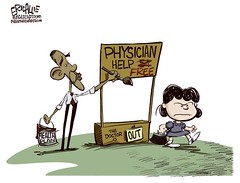"Cash for Clunkers." What a clever nickname for a joke of a $3,000,000,000 program. The new cars people are getting up to $4500 for have to get only 22 miles per gallon. What a joke! I've driven my 2005 Pontiac Vibe for three years now, getting an average of 31 miles per gallon. Even if I wanted to buy a new car, my Pontiac doesn't qualify for any sort of rebate. So
 Image by England via Flickr
Image by England via Flickr
And while I'm at it, what about the multi-billion dollar bailout of homeowners and financial institutions? Countrywide Finance and other companies made ridiculously bad loans to people with ridiculously bad credit. People took out $400,000 house loans on $45,000 salaries. Now they want someone to bail them out for their foolishness. When I moved to Salina, I qualified for an $80,000 house loan, with no money to put down and an annual salary of about $40,000 at the time. I knew that loan would be hard to handle, so I bought a small townhouse for $49,900. I've made every payment--because I didn't get in over my head. But I'm supposed to accept the government's using my tax money to bail out the greedy people whose eyes were bigger than their wallets. Well, screw that.
 Image by wstera2 via Flickr
Image by wstera2 via Flickr
Finally, there are the changes to the health care system. I will be one of the first to say that changes are definitely needed. But why aren't there any incentives for those of us who work hard to stay healthy? How about health club membership price reductions? Tax breaks or lower insurance rates for people who maintain a healthy weight? I know, I know, there are people who are not as lucky as I've been most of my life. I've been fortunate enough to avoid any serious health issues. But I've known people--family and friends--with serious health problems. I think the government should help them with their overwhelming bills. But when my tax money goes to care for Overweight Ollie's high blood pressure medications or Sally Smoker's lung cancer chemotherapy, then I'm getting screwed. Again.
![Reblog this post [with Zemanta]](http://img.zemanta.com/reblog_e.png?x-id=c5d40db0-3d0f-4c85-be29-f308ac5b9171)



![Reblog this post [with Zemanta]](http://img.zemanta.com/reblog_e.png?x-id=a7d83ee3-8589-4b58-9eba-0cc1cd5328a1)

![Reblog this post [with Zemanta]](http://img.zemanta.com/reblog_e.png?x-id=b82bb9bb-5162-432b-91d7-9bb84c38c57f)

![Reblog this post [with Zemanta]](http://img.zemanta.com/reblog_e.png?x-id=561943e8-7200-4db0-9845-4ae0eb622b28)

![Reblog this post [with Zemanta]](http://img.zemanta.com/reblog_e.png?x-id=36c0e5ff-4fc9-42b6-b3fa-3a0f5e3f06b0)

![Reblog this post [with Zemanta]](http://img.zemanta.com/reblog_e.png?x-id=151f441e-0d25-46a9-9d8e-4a6bde05252b)


